Strawberry IPM Newsletter No. 3- June 4, 2021
Strawberry IPM Newsletter No. 3- June 4, 2021
Click on photos to enlarge
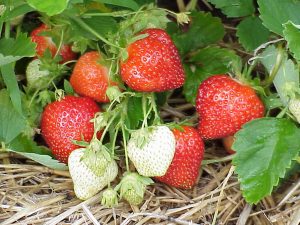
EARLY HARVEST BEGINS IN SOUTHERN MAINE
Spider Mites & Tarnished Plant Bug Numbers Rising in Some Fields.
Twilight Meeting: June 9th, 6:00 pm, at Jordan’s Farm, in Cape Elizabeth
Situation:
Fields have advanced at a rapid pace in most of the state this week, with light harvest of fields that were under rowcovers getting underway. An early season can be challenging for markets. However, school is still in session for many families and growers don’t want the supply of berries to be depleted before the July 4th holiday. Strawberry plant health and crop quality continue to look very good on my visits this week. Many fields got some much-needed rainfall last weekend, which will help reduce plant stress, but may also increase the risk of fungal disease infection.
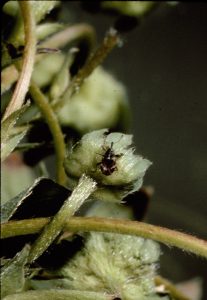
Strawberry bud weevil:
Clipper activity was generally low this week and most fields in the southern part of the state are beyond the stage of susceptibility in all but the latest blooming varieties (e.g. Valley Sunset, Malwina). Scouting should now be focused on these late varieties. Stop scouting for clipper once the later buds have opened (secondaries, tertiaries).

Tarnished plant bug activity has been spotty around the state this week, with some fields showing higher numbers, while others had none. We are starting to see second and third Instar Nymphs as the season progresses. Only one field was over the spray threshold of 4 or more flower clusters infested per 30 sampled. The expected warm-dry weather will likely encourage higher numbers in the coming days. Continue scouting for nymphs in fields with open flowers. Insecticide options for tarnished plant bugs include Assail®, Brigade®, Bifenture®, Dibrom®, Danitol®, and PyGanic®.

White grubs are the larvae of scarab beetles, including Japanese Beetles, Asiatic Garden Beetles and European Chafers. Similar to the root weevils: these grubs feed on the roots of strawberry plants, but tend to be larger, have noticeable legs, and a swollen back end. Infested areas of a field will have weak growth, and plants that wilt in the heat of the day. The roots will be greatly reduced by the feeding, and the grubs can be found in the soil under the affected plants. White grubs are now starting to pupate and adults will soon begin to emerge. These will lay eggs at the base of the strawberry plants, resulting in a new generation of grubs during the late summer and fall. Soil drenches with Admire Pro® or Platinum® can provide control of grubs in new plantings or following renovation in older plantings. Parasitic nematodes may also be applied in the spring and/or fall. See the New England Small Fruit Management Guide for details. [Link provided at the end of the blog post]
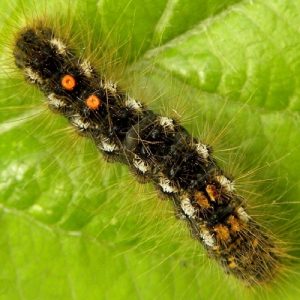
Brown Tail Moths:
Caterpillars of this insect are not likely to feed on strawberry plants. However, if you have infested hardwood trees next to your strawberry fields, you should be aware that many people are very sensitive to the hairs of the caterpillars and could have allergic reactions if the hairs are carried into the field by wind. Workers and customers who may be sensitive to brown tail moths should avoid those areas of the field that may be affected. You can find good information on brown tail moths for you and your customers at the Maine Forest Service website
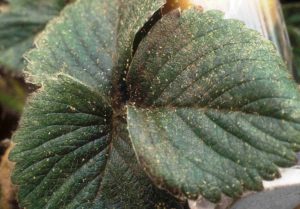
Two-spotted spider mites were found in every field visited this week, and numbers should be expected to rise with the warm weather we’re anticipating in the coming days. While we have been pleased to also see predator mites in most fields, it is unlikely that they will be able to keep spider mite populations below harmful numbers in the days ahead. To protect predator mites, avoid using broad-spectrum insecticides, especially pyrethroids (IRAC 3), which are very toxic to them. Non-pyrethroid chemical control options for two-spotted spider mites include Acramite®, Portal®, Nealta® Savey®, Zeal®, Vendex®, and Oberon®.

Diseases:
The past weekend’s rain and subsequent showers have created conditions amenable to gray mold infection. If it has been more than 14 days since the last fungicide application, or your fields have received more than an inch of rain or overhead irrigation, another fungicide application should be made to protect later opening flowers and developing fruit.
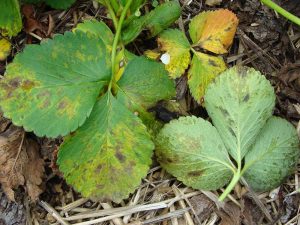
Angular leaf spot continues to be found in a couple of fields, but seems to have been held in check by drier weather and applications of hydrogen dioxide (OxiDate®). At this point the concern is that the infection of the calyxes can result in black berry stems and caps.
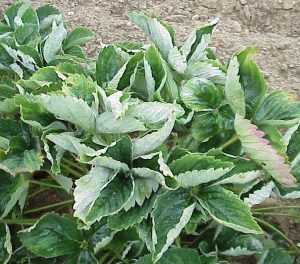
Powdery mildew:
There are more indications of powdery mildew in strawberry fields this week. Warm-humid weather encourages the symptoms and spread of this fungus. Look for upward cupping of the leaves and reddish streaking or lesions on the leaf and flower stems. Some fungicides offer protection against both powdery mildew and gray mold, including captan + Topsin-M®, or Pristine®. Other products registered for powdery mildew include: Orbit®, Rally®, Torino® Fontelis®, Procure® and Luna Sensation®.
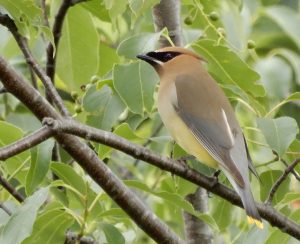
Birds, especially cedar waxwings, will soon be moving into fields to feed on ripe fruit. When cedar waxwings are a problem, only keeping a near constant presence in the field and eliminating roosting sites can reduce the damage. Some chemical repellents containing methyl anthranilate (e.g. Avian Control®), are registered for use on strawberries. Although most scientific studies with these products have not found them to be very effective, some growers have claimed good results. Remember that songbirds are protected by law and should not be killed. However, permits may be issued for killing birds by the U.S. Fish and Wildlife Service if they receive a recommendation for such a permit from the Maine Wildlife Services Office (part of the USDA Animal and Plant Health Inspection Service) in Augusta, along with an application from the grower. There is a $50 fee for the application, and it may take over a month for the permit to be processed. However, the permit is good for one year, so if you have problems this season, you may consider applying for a permit this winter, which would allow you an option to kill birds, if necessary, next season. The Wildlife Damage Office has recommendations for managing birds in crops, and also has some control options available through their office. For more information on permits or bird control contact the office in Augusta at 207.629.5181. The office is located in the Capital West Business Center at 79 Leighton Road in Augusta.
Spring Growers’ Twilight Meeting
The Maine Vegetable & Small Fruit Growers Association will be having a Spring Twilight Meeting on Wednesday, June 9 at 6 pm at Jordan Farm, 21 Wells Road, Cape Elizabeth. We will have the usual strawberry update and a discussion of how things went last year for pick-your-own operations under the COVID restrictions. In addition: there will be a tour of Jordan Farm’s new pesticide storage building that was built with an NRCS grant, a discussion of the current labor situation, and a talk about interseeding cover crops by Cumberland County Extension agent Jason Lilley. One pesticide applicator recertification credit will be available to participants. Hope to see you there!
2021-2022 New England Small Fruit Management Guides The latest edition of the Guide will be available online here soon
Sincerely,
David T. Handley
Vegetable and Small Fruit Specialist
Highmoor Farm Pest Management Unit
P.O. Box 179 17 Godfrey Dr.
Monmouth, ME 04259 Orono, ME 04473
207.933.2100 1.800.287.0279
Where brand names or company names are used, it is for the reader’s information. No endorsement is implied nor is any discrimination intended against products with similar ingredients. Always consult product labels for rates, application instructions and safety precautions. Users of these producers assume all associated risks.
The University of Maine is an equal opportunity/affirmative action institution.
